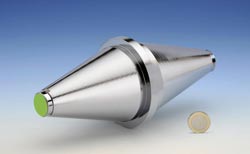The most stable laser in the world

The size of the new silicon resonator compared to the size of a coin (Fig. PTB)<br>
A laser with a frequency stability so far unequalled: This is the result of a research cooperation of the Physikalisch-Technische Bundesanstalt (PTB) within the scope of the Excellence Cluster QUEST (Centre for Quantum Engineering and Space-Time Research) with colleagues from the American NIST (National Institute of Standards and Technology)/JILA.
Their development, about which they report in the scientific journal “Nature Photonics”, is important for optical spectroscopy with highest resolution, e.g. of ultra-cold atoms. But, above all, an even more stable interrogation laser is now available for use in optical atomic clocks.
Optical atomic clocks require laser sources that radiate light with an extremely constant frequency. Commercial laser systems are not suited for this purpose without additional measures. However, this can be achieved by stabilizing them, for example, with the aid of optical resonators. These are composed of two highly reflecting mirrors which are kept at a fixed distance by means of a spacer. The decisive aspect is the following: In analogy to an organ pipe, the resonator length determines the frequency with which light can begin to oscillate in the resonator. Consequently, a resonator with a high length stability is required for a stable laser, i.e. the distance between the mirrors must be kept as constant as possible.
Modern resonator-stabilized laser systems have meanwhile been technically developed to such an extent that their stability is only limited by the thermal noise of the resonators. Similar to the Brownian motion of molecules, the atoms in the resonator are constantly moving and are, thus, limiting its length stability. Up to now, resonators have been made of glass, whose disordered and “soft” material structure shows particularly strong movements.
For the new resonator, the research group has used single-crystal silicon, a particularly “stiff” and thus low-noise material. Cooled down to a temperature of 124 K (-149 degrees Celsius), silicon is characterized by an extremely small thermal expansion, and the remaining thermal noise is additionally reduced.
To operate the resonator at this temperature, the researchers had to design, first of all, a suitable low-vibration cryostat. The result is something to be proud of: Comparison measurements with two glass resonators allowed the scientists to demonstrate a frequency stability so far unequalled of 1 · 10-16 for the laser stabilized to the silicon resonator.
This allows them to remove an important obstacle in the development of even better optical atomic clocks, because the stability of the lasers used is a critical point. The “pendulum”, i.e. the swinging system of such a clock, is a narrow optical absorption line in an atom or ion, whose transition frequency is read out by a laser. The linewidth of these transitions typically amounts to a few millihertz, a value which could not be reached by glass resonators due to their limited length stability.
But this is now possible. The laser to which the silicon resonator is stabilized reaches a linewidth of less than 40 mHz and can, thus, contribute to moving into a new dimension in the development of optical atomic clocks. This work could also benefit optical precision spectroscopy, another focal point of research of the Excellence Cluster QUEST.
“For the future, there is still room to improve the optical mirrors whose thermal noise limits the achievable stability”, explains PTB physicist Christian Hagemann. Therefore, the researchers will in future go down to even lower temperatures and use novel highly reflecting structures to improve the frequency stability by another order of magnitude
Scientific publication
Kessler, T.; Hagemann, C.; Grebing, C.; Legero, T.; Sterr, U.; Riehle, F.; Martin, M.J.; Chen, L.; Ye, J.:
A sub-40-mHz-linewidth laser based on a silicon single-crystal optical cavity. Nature Photonics, DOI: 10.1038/nphoton.2012.217,
http://www.nature.com/nphoton/journal/vaop/ncurrent/full/nphoton.2012.217.html
Contact:
Christian Hagemann, PTB Working Group 4.32 “Quantum Optics with Cold Atoms”,
phone: +49(0)531) 592-4357,
e-mail: christian.hagemann@ptb.de
Media Contact
More Information:
http://www.ptb.deAll latest news from the category: Physics and Astronomy
This area deals with the fundamental laws and building blocks of nature and how they interact, the properties and the behavior of matter, and research into space and time and their structures.
innovations-report provides in-depth reports and articles on subjects such as astrophysics, laser technologies, nuclear, quantum, particle and solid-state physics, nanotechnologies, planetary research and findings (Mars, Venus) and developments related to the Hubble Telescope.
Newest articles

Security vulnerability in browser interface
… allows computer access via graphics card. Researchers at Graz University of Technology were successful with three different side-channel attacks on graphics cards via the WebGPU browser interface. The attacks…

A closer look at mechanochemistry
Ferdi Schüth and his team at the Max Planck Institut für Kohlenforschung in Mülheim/Germany have been studying the phenomena of mechanochemistry for several years. But what actually happens at the…

Severe Vulnerabilities Discovered in Software to Protect Internet Routing
A research team from the National Research Center for Applied Cybersecurity ATHENE led by Prof. Dr. Haya Schulmann has uncovered 18 vulnerabilities in crucial software components of Resource Public Key…





















